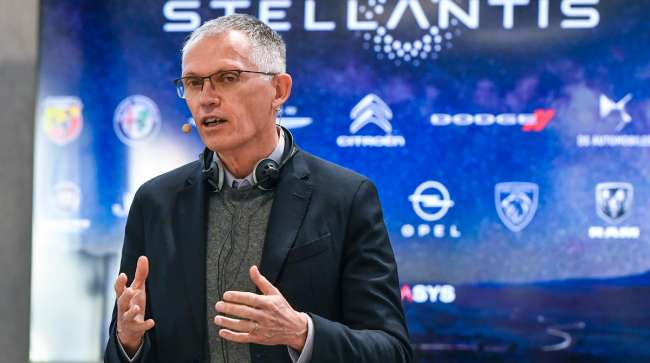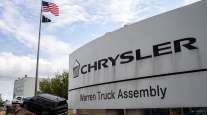Tavares Addresses Stellantis’ Sales Drop, Management Shakeup

[Stay on top of transportation news: Get TTNews in your inbox.]
DETROIT — Stellantis is fixing its slowing U.S. sales at the right pace after fumbling a marketing plan earlier this year, CEO Carlos Tavares told reporters Oct. 13.
Tavares, who recently removed the company’s chief financial officer and chief operating officers for North America and Europe in a management restructuring, told reporters at the Paris Motor Show that he takes responsibility for both the company’s setbacks and successes.
“If I don’t want that responsibility, I should do something else,” said Tavares, who reiterated his plan to retire when his contract expires in 2026. The board confirmed last month that it’s searching for a successor.
Stellantis, formed from the 2021 merger of France’s PSA Peugeot and Fiat Chrysler Automobiles, has faced challenges this year in both Europe and the U.S.
In the European Union, the company is grappling with reductions in government electric vehicle subsidies and competition from Chinese manufacturers as it aims to increase EV sales to meet its goal of cutting greenhouse gas emissions 55% by 2030. The EU has proposed tariffs on imported Chinese EVs.
McLeod Software CEO Tom McLeod explores the potential for artificial intelligence to boost efficiency and build resilience. Tune in above or by going to RoadSigns.ttnews.com.
U.S. sales, long the company’s primary source of revenue, have been declining for most of the year. In the second quarter, Stellantis introduced a new marketing plan with incentives to offset high sticker prices, but it failed to attract sufficient buyers. Sales fell 20%, and they’re down over 17% for the first nine months of the year. In contrast, the rest of the auto industry saw a 1% increase from January through September.
In June, U.S. dealer inventory ballooned to just over 430,000 vehicles.
However, Tavares said Oct. 13 that inventory has decreased by 52,000 in recent months, and the company aims to reduce it to below 350,000 by Christmas for a “fresh start” in the new year. He expects the new leadership team to generate stronger profits and improved customer satisfaction.
Tavares said he should also be credited for successfully merging the companies and making Peugeot and Opel profitable over the past decade.
He described the company as being in a “Darwinian period,” stating that all options, including plant closures or brand discontinuations, are under consideration. “When you are fighting for survival, you have to consider everything is on the table.”
Challenges in Europe and the U.S. contributed to a 48% decrease in first-half net profits compared to the same period last year. This led Stellantis to revise its full-year financial forecasts downward. The company now anticipates ending the year with negative cash flow of 5 billion euros to 10 billion euros ($5.6 billion to $11.2 billion) instead of positive cash flow.
The company also faces labor issues. In Italy, a union has called for a one-day strike on Oct. 18 to protest production cuts. In the U.S., the United Auto Workers is threatening strikes at several plants, alleging that Stellantis isn’t fulfilling commitments to build vehicles.
Chief among the issues is a company promise in the UAW’s contract to reopen a factory in Belvidere, Ill., as well as build a parts warehouse and a new electric vehicle battery plant in the city.
In a letter attached to the contract, Stellantis agreed to produce new gas and electric midsize pickups in Belvidere starting in 2027.
UAW President Shawn Fain contends Stellantis wants to postpone reopening the plant until after the contract expires in 2028, when it would no longer be legally obligated to do so. He’s also concerned about reports that Stellantis plans to move production of the Dodge Durango SUV from Detroit to Canada.
“It is gross mismanagement by top executives that is killing this company,” Fain said in a statement.
The company denied plans to relocate the SUV and stated that the Belvidere project has been delayed due to market conditions, not canceled. Stellantis notes that the contract includes language stating plant investments must be approved by the company and may not proceed if market conditions change.
Several local union offices have filed grievances over the changes, and Stellantis has sued, seeking monetary damages should the union strike.
Ivan Drury, director of insights at Edmunds, said Stellantis has long lacked affordable models that many U.S. buyers now seek.
The coronavirus pandemic and global computer chip shortage temporarily shielded the company from this issue, Drury said, as many buyers invested in large, expensive vehicles when travel and dining out were limited.
With the chip shortage, automakers focused production on high-profit, fully equipped vehicles.
But now, as the chip shortage has eased, most people are looking for more affordable transportation, with still-high interest rates, Drury said. “You’ve got people who are looking at practicality and just want basic stuff,” he said. “They (Stellantis) don’t have anything in that realm.”
As a result, Stellantis vehicles sit on dealer lots for 100 days before selling, double the industry average, Drury said.
Much of Stellantis’ product lineup is old, with few recent updates, including its top seller, the Ram pickup, which got only a modest refresh this year, said Sam Abuelsamid, mobility analyst for Guidehouse Insights.
“They don’t necessarily have the right products in the right segments,” he said. “There’s a bunch of stuff coming, but it’s not here yet.”
The company has little in the way of affordable vehicles. For example, the Jeep Compass small SUV has one version starting around $26,000 excluding shipping, most versions are priced over $30,000.
The company does have plans for a new small electric Jeep costing around $25,000, Abuelsamid said.
Dealers have revolted, calling publicly for increased discounts to move the vehicles.
Drury doesn’t see a quick way out of the situation because it can take years to roll out new vehicles to match market demand. The company got out of midsize and compact cars in the U.S. nearly a decade ago.
So there’s little Tavares can do to fix things quickly, Abuelsamid said. “Aside from incentives and price cuts, not really,” he said.
Want more news? Listen to today's daily briefing below or go here for more info:





